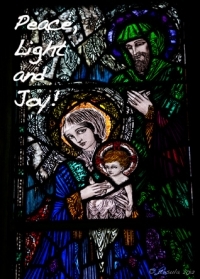.jpg)
Tomb Façade – Little Petra
Some time between the 1st century BC and the 1st century AD, the Nabataeans – an ancient tribe of Arabian nomads – carved buildings into the sandstone walls of the Siq al-Barid, or Cold Canyon, in Jordan.
Even without the elaborate tomb and temple architecture carved into the walls of the sandstone canyons, this mountainous desert terrain – high above sea level – is magnificent.
Adding in the majestic artifacts created over two thousand years ago renders the landscape truly awe-inspiring!
A few hours north of Wadi Rum (see: A Morning in Wadi Rum) and south of the Dead Sea, this high plateau honeycombed with sandstone formations is punctuated with natural and man-made caves and structures.
This is Little Petra: known in Arabic as Siq al-Barid, or Cold Canyon. Six kilometres (four miles) north of the centre of Petra, this smaller – but still amazing – site is included in the UNESCO World Heritage Site-listing for its cultural, archaeological, historical, and aesthetic value.
The buildings were carved out by the Nabataeans (Nabateans) some time between the 1st century BC and the 1st century AD. The Nabataeans were a fiercely independent nomadic Bedouin tribe who emerged as a distinct civilization between the 4th and 2nd centuries BCE. The Nabataean Kingdom controlled many of the trade routes between the Arabian and Sinai Peninsulas, bringing its people considerable wealth and influence across the ancient world.
Although no one is sure, archaeologists believe Little Petra was a suburb of Petra, the Nabataean capital, and was meant to house visiting Silk Road traders. The cool of the canyon would have been a perfect place for long-distance travellers to stop: to the east, the Arabian Desert opens up. To the west, the rugged terrain drops down into the Jordan Rift Valley, with lands as low as 400 metres (1,300 ft) below sea level. The immediately surrounding plains were fertile, allowing visiting animal trains to graze extensively, and allowing agriculture – including wine-grape growing – to flourish.
As the name implies, this site is much smaller than Petra itself (Watch this space!). I was pleased that I got to see it before setting foot in the larger and busier archaeological grounds: it allowed me to appreciate its beautiful Hellenistic-influenced architecture without being completely overwhelmed!
Join me on a tour:
.jpg)
Petra Hills
The sign outside the Sita Bazaar – next to the Petra Viewpoint where we alighted our bus for a comfort stop – calls this the “Third Best View in the World.”
.jpg)
Wadi Musa – The Valley of Moses
This is a biblical landscape: you can walk down through the valley, past the rock from which Moses reputedly struck water, and on to the Nabataean complex of Petra.

Entry to Little Petra
We drove past the bustling town of Wadi Musa and the larger archaeological site of Petra, and parked on the gravel and sand outside Little Petra.

Entrance to the Triclinium
We are immediately greeted with the large, rock-cut tomb with a classical façade that sits at the outside of the site. Sometimes called the triclinium (a room containing couches along three sides), the chamber inside was never finished, so the building would never actually have been used as a burial place.

Entrance to the Tomb
The rock-cut doorway features two flat relief pillars with quarter columns and Nabataean capitals. The frieze over the doorway incorporates the classical Greco-Roman decorative style adopted by the Nabataeans.

Bedouin Souvenirs
There is no entry charge to this site: even the souvenir stands are low-key.

Entry to Siq al-Barid
The entry to the canyon is so narrow that we wait for others to exit before trying to get through.

Souvenirs or Artifacts

Through the Canyon
We work our way through the steep-sided canyon …

Through the Siq
… before coming out into more-open areas.

Guide in a Cave Room
Our local guide gave us an explanation of what archaeologists think these areas were for.

Cave Rooms
There are carved cave entrances everywhere.

Woman Spinning
In yet another cave, an Arab woman in Nabataean costume demonstrates how to spin wool.

Coffee, Tea, and Trinkets

View from the Biclinium
The second, wider, area of Siq al-Barid contains a two-storey rock structure which we access via carved external stone stairs, and which gave us good views over the cliffs on the opposite side.

Painting in the Biclinium
The room here contains Nabataean paintings on the stucco walls and ceiling, in what is called a Hellenistic Alexandrian style.

Textured Canyon Walls
The walls of the canyon are so textured and pock-marked that the man-made features blend in with those created by nature, …

Stairs
… but the natural cliffs are extensively carved with cisterns, cave rooms, and weathered stairways leading in all directions.

Rock-cut Staircase
A narrow, steep, and well-worn stairway leads to the top of the canyon …

Carved Key
… where I am greeted with ancient artifacts, …

View Across the Hills
… and views across the jagged sandstone crags …

The Next Wadi
… and into the next rugged wadi, or dry river valley.

Kettle on the Fire
There is also the opportunity for a cup of coffee or tea.

Back in the Siq al-Barid
I made my way – very carefully – back down the treacherous stairway to the canyon floor …

Caves and Cloths
… and back past the two-story biclinium to find my way out of the little complex.
I was so glad to have visited this amazing site!
Looking back at my pictures of these two-thousand year-old structures, I continue to be astounded by the engineering abilities and architectural creativity of these ancient people.

Until next time,
Happy Travels!
Pictures: 15October2019





























.png)
.png)

